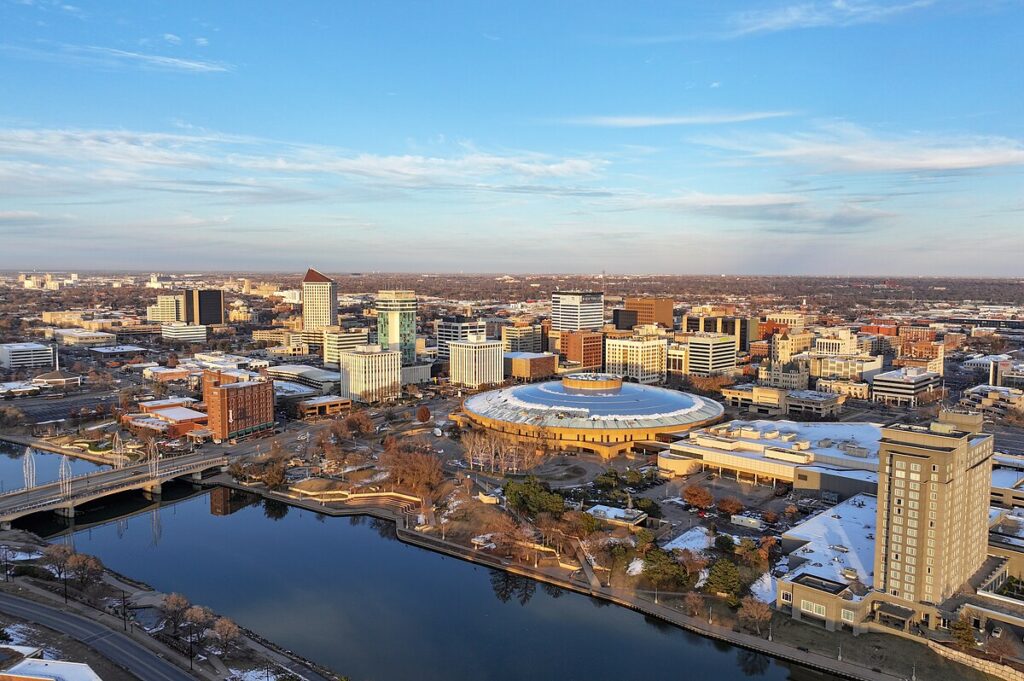
Moving to Wichita, Kansas: A Comprehensive Relocation Guide
Considering moving to Wichita, Kansas? This historic aviation city offers affordable living, aerospace heritage, and big-city amenities. With approximately 397,000 residents in 2025 (metro 647,000+), Wichita combines Air Capital character with cultural offerings and Kansas’ largest city atmosphere.
Demographic Profile to Consider If Moving to Wichita:
Wichita’s 2025 population is approximately 397,000 residents, making it Kansas’ largest city by far, with the metro exceeding 647,000 in Sedgwick County. The median age is around 36 years, with working families, aerospace workers, diverse residents, and retirees. The population is approximately 72% White, 11% Hispanic, 10% Black or African American, 5% Asian. Wichita features downtown along the Arkansas River with revitalized districts, extensive suburban development, aerospace manufacturing dominance, and serves as Kansas’ economic and cultural hub. The city attracts working families, aerospace professionals, and those seeking Kansas’ biggest city with affordable living. Wichita appeals to working-class to middle-class residents prioritizing affordability and career opportunities. The community balances Air Capital aerospace heritage with cultural amenities and maintaining big-city character with Midwest values. Find trusted local services for moving, living, and working in Wichita.Wichita Relocation Directory
Cost of Living to Consider If Moving to Wichita:
Wichita offers exceptional affordability for a metro its size. Median home values range from $160,000 to $240,000 in 2025, among the most affordable metros in America while providing big-city amenities and aerospace employment. The median household income is approximately $58,000. Rental properties average $850 to $1,300 monthly. Kansas has no state income tax on Social Security; individual income tax is progressive 3.1%-5.7%. Property taxes are moderate. Overall cost of living is very low for the career opportunities and metro amenities, making Wichita highly attractive for working families, aerospace workers, young professionals, and those seeking big-city living with small-city costs. The city provides tremendous value with stable aerospace employment and cultural offerings. Housing costs create exceptional accessibility for diverse income levels with aerospace wages enabling comfortable middle-class living.
Economy and Job Market:
Wichita’s economy centers on aerospace manufacturing (Air Capital of the World designation), healthcare, and diverse sectors. Major employers include Spirit AeroSystems (massive Boeing supplier employing thousands), Textron Aviation (Cessna and Beechcraft), Airbus, Collins Aerospace, Koch Industries operations, Cargill, hospitals including Ascension Via Christi and Wesley Healthcare, and various manufacturers. The aerospace industry dominates employment and economic identity. Healthcare provides extensive jobs. Typical industries include aerospace manufacturing and engineering, healthcare, agriculture business, and manufacturing. The economy depends heavily on aviation though healthcare provides stability. Aerospace jobs offer good wages and benefits. The job market attracts engineers, manufacturing workers, and professionals seeking aerospace career opportunity with affordability.
Education:
Wichita Public Schools (USD 259) serves city students with multiple high schools. School quality varies dramatically requiring extensive family research with some schools excellent and others struggling. Wichita State University offers comprehensive programs creating college atmosphere and supporting aerospace industry. Friends University and Newman University provide additional higher education. The educational infrastructure serves the large, diverse population with quality varying significantly by school and neighborhood.
Recreation and Lifestyle:
Wichita offers revitalized downtown along the Arkansas River with Delano District entertainment, Old Town nightlife district, and riverfront trails. The city features Exploration Place (science museum), Wichita Art Museum, Botanica gardens, Sedgwick County Zoo (major regional zoo), and Intrust Bank Arena hosting concerts and events. Residents enjoy Kansas Aviation Museum celebrating Air Capital heritage, extensive park system, and River Festival. The lifestyle emphasizes affordable big-city living, aerospace pride, diverse culture, and Kansas values. The four-season climate enables varied activities. The community values Air Capital heritage (tremendous pride in aerospace history), affordability, working-class roots, and big-city amenities with Midwest character. Living in Wichita means accepting Kansas isolation (geographic center of U.S., substantial drives to major coastal metros), economy dependent on aerospace cyclicality, significant variation in neighborhood quality, some urban challenges, and being Kansas’ biggest city in a smaller state while enjoying exceptional affordability enabling quality of life on aerospace wages, Air Capital heritage creating unique identity, big-city cultural amenities unusual for costs, and stable aerospace employment with good wages defining America’s most affordable big city where aerospace meets exceptional value and Air Capital pride creates distinctive identity.
Healthcare and Services:
Wichita residents access comprehensive healthcare through Ascension Via Christi St. Francis, Wesley Healthcare, University of Kansas School of Medicine-Wichita, and extensive facilities. The concentration of hospitals serves south-central Kansas as the regional medical hub with quality care and medical education.
Transportation:
Wichita is accessed via Interstate 35, Interstate 135, U.S. Route 54, Kansas Highway 96 (Kellogg Avenue), and various corridors. Wichita Dwight D. Eisenhower National Airport provides good commercial service with reasonable connectivity. Wichita Transit operates bus service throughout the city. Most residents use personal vehicles. The central U.S. location creates distance to coastal metros though Kansas City is 3 hours northeast.
Conclusion:
Moving to Wichita in 2025 offers affordable big-city living with Air Capital aerospace heritage, cultural amenities, and exceptional value. The city’s combination of America’s lowest big-city housing costs, stable aerospace employment, and comprehensive urban amenities makes it ideal for working families, aerospace professionals, and those seeking the nation’s most affordable metro where Air Capital pride meets exceptional value and aerospace heritage defines Kansas’ largest and most dynamic city offering big-city living at small-city costs.

